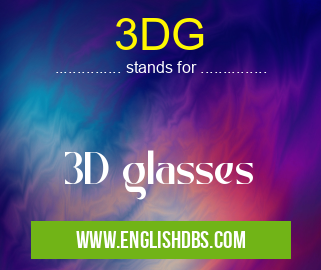What does 3DG mean in ASTRONOMY
3DG is an acronym that stands for 3D glasses. These glasses are specifically designed to enhance the viewing experience of three-dimensional (3D) content. By employing advanced optical technology, they enable viewers to perceive depth and dimension in images and videos that would otherwise appear flat.

3DG meaning in Astronomy in Academic & Science
3DG mostly used in an acronym Astronomy in Category Academic & Science that means 3D glasses
Shorthand: 3DG,
Full Form: 3D glasses
For more information of "3D glasses", see the section below.
How 3D Glasses Work
The human brain interprets depth by utilizing the slight differences in the images received by each eye. 3D glasses capitalize on this principle by presenting slightly different images to each eye. To achieve this, the glasses employ lenses that filter out specific wavelengths of light, allowing only those intended for the corresponding eye to pass through.
Types of 3D Glasses
There are two primary types of 3D glasses:
-
Anaglyph glasses: These glasses use colored lenses, typically red and cyan, to separate the images for each eye. The colors are chosen to match the filters applied to the projected or displayed images.
-
Polarized glasses: These glasses utilize lenses that polarize light in different directions. The projected or displayed images are also polarized to align with the corresponding lens, ensuring that each eye receives the intended image.
Advantages of 3D Glasses
-
Enhanced immersion: 3D glasses provide a more immersive viewing experience by creating a sense of depth and presence within the virtual world.
-
Improved entertainment: 3D technology has significantly enhanced the entertainment industry, offering more realistic and engaging movies, video games, and other forms of entertainment.
-
Medical and scientific applications: 3D glasses are also utilized in various medical and scientific applications, such as surgical planning and molecular modeling, where accurate depth perception is crucial.
Essential Questions and Answers on 3D glasses in "SCIENCE»ASTRO"
What are 3D glasses?
3D glasses, also known as stereoscopic glasses, are devices worn over the eyes to create the illusion of depth in two-dimensional (2D) images. They work by presenting slightly different images to each eye, which the brain then combines to perceive depth.
How do 3D glasses work?
3D glasses typically use one of two technologies: passive or active. Passive glasses have polarized lenses that filter out specific wavelengths of light, allowing each eye to see a different image. Active glasses use electronic shutters that rapidly alternate between blocking and unblocking each eye's view, creating the illusion of depth.
What are the different types of 3D glasses?
There are various types of 3D glasses, including:
- Polarized glasses: Use polarized lenses to filter out specific light wavelengths.
- Anaglyph glasses: Use colored lenses (usually red and cyan) to create the illusion of depth.
- Shutter glasses: Use electronic shutters to block and unblock each eye's view.
- Diffractive glasses: Use diffraction gratings to create multiple viewpoints.
What are the benefits of using 3D glasses?
3D glasses can enhance the viewing experience by:
- Creating a sense of depth and immersion.
- Providing a more realistic and engaging experience.
- Reducing eye strain and fatigue.
What are the limitations of 3D glasses?
Some limitations of 3D glasses include:
- Potential discomfort or eye strain for some users.
- Reduced brightness and color accuracy compared to 2D viewing.
- Not all content is suitable for 3D viewing.
How do I choose the right 3D glasses?
Consider the following factors when choosing 3D glasses:
- The type of 3D technology used (active or passive).
- The compatibility with your display device.
- The level of comfort and fit.
- The desired price range.
Final Words: 3DG (3D glasses) play a vital role in enabling the perception of depth and dimension in 3D content. They enhance the viewing experience for entertainment purposes and provide practical benefits in medical and scientific fields. As the technology continues to evolve, we can expect even more innovative and immersive applications for 3D glasses in the future.
